Timely harvest and proper storage help maintain the quality and freshness of garden vegetables. This publication describes how and when to harvest vegetables; special harvest preparations and storage requirements; and appropriate length and kinds of storage.
“Ideal” storage conditions for many vegetables are not attainable around the average home or farm. So, recognizing the limitations of the best storage available is important.
Refrigerators can be used for storage. If two refrigerators are available, set one at a cold temperature (32 to 40 degrees F) and the other at a cool temperature (45 to 50 degrees F). If only one refrigerator is available and it is set for normal operation, the temperature in the center storage section is usually between 38 and 42 degrees F. Check the setting of the temperature control by placing a thermometer in different places in the refrigerator. Remember, also, that frequent opening of a refrigerator door raises the temperature inside.
Basements also are possible storage places. Temperatures in most heated/air-conditioned basements will usually be 65 degrees F or warmer in summer and 60 degrees F or cooler in winter. Separate sections can be partitioned to vary the temperature and humidity. Outdoor air or wetted sacks can also be used to vary the temperature and humidity. Unheated basements, if well ventilated, can provide good storage conditions for some vegetables.
Different vegetables require different temperature and humidity levels for proper storage.
Note
This publication uses the following terms when describing some harvest times:
- Light freeze: 28 to 32 degrees F
- Moderate freeze: 24 to 28 degrees F
- Severe freeze: Less than 24 degrees F
Cold, moist storage
(32 to 40 degrees F, 90 to 95 percent relative humidity)
Root crops
- Beets
Begin harvest when beet is 1 inch in diameter or smaller for baby beets. Main harvest is when beets are 2 to 3 inches. Tender tops make excellent greens regardless of the size of the rootball. Harvest spring-planted beets before hot weather (July). Harvest fall beets before the first moderate freeze. For storage, wash roots, trim tops to 1/2 inch, place in perforated plastic bags and store in a refrigerator, cold moist cellar or pit. Storage life is 2 to 4 months.
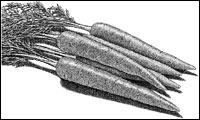
- Carrots
Harvest spring carrots before hot weather (July). Baby carrots may be harvested when roots are 3 inches long. Fall-planted carrots should be harvested before the first moderate freeze. For storage, wash roots, trim tops to 1/2 inch, place in perforated plastic bags and store in a refrigerator, cold moist cellar or pit. Storage life is 2 to 4 months. With a heavy layer of mulch, carrots may also be overwintered outdoors in the ground. - Horseradish
Harvest after several severe freezes. Store in the ground all winter; mulch with straw or leaves, and dig when needed. - Parsnips
Harvest in late fall after several moderate freezes. Exposure to cold develops a sweeter flavor. For storage requirements, see carrots.
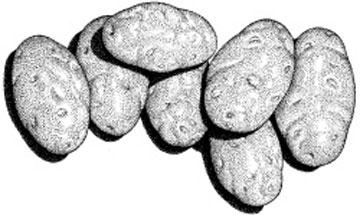
- Potato, Irish
Harvest in July when the tops have yellowed or died. Do not leave in ground exposed to high soil temperatures and sun. Wash potatoes and remove the diseased or damaged ones. Cure for about 1 week in a shaded, well-ventilated place, such as an open barn, shed or garage. Avoid exposing tubers to light. Store in as cool a place as possible at harvest time. You are not likely to find ideal storage conditions (40 degrees F, 85 to 90 percent relative humidity) at this time of year other than refrigerated cold storage. Cool basements are probably the best storage available. Keep humidity high and provide good ventilation. Storage time is 2 to 4 months.
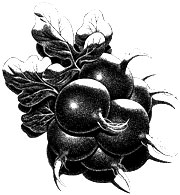
- Radish
Harvest when 1/2 to 1 inch in diameter. Wash roots, trim both taproot and tops, and store in plastic bags in a refrigerator for up to a month. Winter or black radishes are stored the same as carrots. - Salsify
See parsnips for harvest and storage. - Turnip
Turnips can be harvested from the time they are 1 inch in diameter. They are best as a fall crop and can withstand several light freezes. Store the same as carrots. Turnip greens may be harvested and used the same as beet greens.
Cole crops (cabbage group)
- Broccoli
Harvest terminal head while florets are still tight and of good green color. Smaller side heads will develop. Store in perforated plastic bags for up to 1 week in a refrigerator. Freeze any surplus. Best quality will be found in heads that are harvested during cool weather. - Brussels sprouts
Harvest the sprouts (small heads) when they are firm; begin from the bottom of the plant. Sprouts can stand several moderate freezes. Harvest all sprouts prior to the first severe freeze and store in a refrigerator in perforated bags for up to 3 weeks. Freeze any surplus.
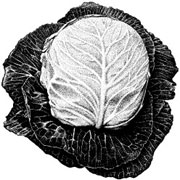
- Cabbage
Harvest when heads are firm. Remove loose outer leaves. Store cabbage in a refrigerator, cold cellar or outdoor pit in plastic bags for up to 2 months.

- Cauliflower
To blanch, tie outer leaves above the head when curds are about 1 to 2 inches in diameter (except colored types). Heads will be ready for harvest about 2 weeks later. Cauliflower may be stored in perforated plastic bags in a refrigerator for up to 2 weeks. Freeze any surplus. - Chinese cabbage
Grows best in the fall, although varieties that mature in less than 55 days can be planted in early spring. In the fall, harvest head after the first moderate frost. Harvest spring cabbage when heads solidify but before a seed stalk forms. Store in perforated plastic bags in a refrigerator, cold cellar or outdoor pit. Chinese cabbage will keep for up to 2 months. - Kohlrabi
For standard types, harvest when the swollen stems are 2 to 3 inches in diameter. Stems become woody if left too long before harvest or if grown under poor conditions. Giant, heirloom types may reach 1 foot in diameter and still retain high quality. Cut off root and leaf stems and store in plastic bags as indicated for carrots. Storage life is 2 to 4 weeks.
Greens
- Chard, Swiss
This is a summer green that is harvested continuously. Merely break off the outer leaves. Swiss chard is a beet relative developed for its top. A spring planting will provide greens from early summer to the first moderate freeze. Store in plastic bags in a refrigerator for up to 2 weeks.
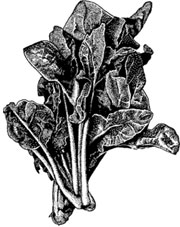
- Collards, kale, mustard, spinach
Harvest the leaves and leaf stems of greens when they reach suitable size. Either harvest the whole plant or the outer, larger leaves. Greens do not store well but may be kept in plastic bags in a refrigerator for up to 2 weeks. Freeze any surplus.
Salads
- Endive (Escarole)
Harvest whole plant. Wash thoroughly to remove soil and sand. Gather leaves together and tie with rubber band. Store in plastic bags in a refrigerator for up to 3 weeks.

- Lettuce
Head, semi-head and leaf lettuce can be stored for up to 2 weeks in perforated plastic bags in a refrigerator. Individual leaves may be harvested at any stage of development before the plants bolt (go to seed). For best quality, successive plantings at two-week intervals are suggested. - Parsley
Parsley will overwinter if planted in a protected place such as a coldframe. If planted in the open, it can be carefully lifted with a ball of soil just before the soil freezes, potted and taken into the house in a cool, sunny room and harvested for several weeks. Parsley leaves will keep in plastic bags in a refrigerator for about 1 week.
Legumes
- Lima beans
Harvest when pods have filled. For tender limas, harvest when a bit immature; for “meaty” limas, harvest when mature. Shelled limas can be stored in perforated plastic bags in a refrigerator for about 1 week. Surplus limas can be canned or frozen.

- Garden peas
Harvest when pods have filled. For tender peas, harvest when a bit immature; for “meaty” peas, harvest when mature. Unshelled peas can be kept in a perforated plastic bag in a refrigerator for about 1 week. Freeze or can surplus. Oriental or snow pea types are harvested when pods are full-sized but before the peas inside begin to swell. Edible podded or snap peas are harvested when pods have filled out but before the peas inside become starchy. - Southern peas (Crowder, Purple Hull, etc.)
For fresh use, freezing or canning, harvest when seeds are large and plump but moist. Either shelled or unshelled peas may be stored in a refrigerator for several days.
Other vegetables
- Asparagus
Harvest by snapping 6- to 12-inch spears off at ground level before the top begins to fern out. Store in plastic bags in a refrigerator for up to 1 week. Freeze or can any surplus.
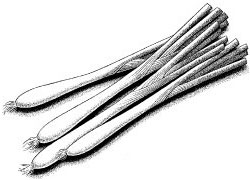
- Onions, green
Harvest green onions when they attain sufficient size. Cut off roots; remove top, leaving an inch of green. Place in plastic bags and store in a refrigerator for up to 2 weeks. - Rhubarb
Harvest leaf stalks when 1/2 to 1 inch in diameter. Do not use leaves. Rhubarb can be stored in perforated plastic bags for up to 3 weeks in a refrigerator. Surplus rhubarb can be frozen.

- Sweet corn
Harvest sweet corn when kernels are plump and tender. Silks will be dry and kernels filled. Check a few ears for maturity: Open top of ear and press a few kernels with thumbnail. If milky juice exudes, it is ready for harvest. Harvest at peak of quality, husk to conserve space, and store in plastic bags for no more than 2 days in a refrigerator. The new super sweet varieties will store for 1 week or more. Freeze or can surplus corn. Baby corn may be harvested just as silks emerge, before the ear is 3 inches long.
Cool, moist storage
(45 to 50 degrees F, 80 to 90 percent relative humidity)
Vine crops

- Cantaloupe (muskmelon)
Harvest when the stem slips easily from the fruit. Lift the melon; if ripe it should separate easily from the vine. Store ripe melons in a refrigerator in a plastic bag for up to 10 days. Try a few boxes of frozen melon balls. - Squash, summer
Harvest when fruit is young and tender. Skin should be easily penetrated with the thumbnail. Store for up to 1 week in a perforated plastic bag in a refrigerator.
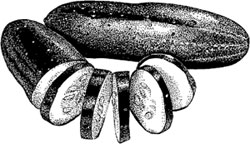
- Cucumber
Harvest cucumbers before seeds become half-size. Timing will vary with variety. Most varieties will be 1-1/2 to 2-1/2 inches in diameter and 5 to 8 inches long. Pickling cucumbers will be a bit more blocky and not as long as slicers. Store slicing cucumbers in the warmest part of a refrigerator (45 to 50 degrees F) in plastic bags. Storage life is about 1 week. Pickling cucumbers should be cooled quickly in ice water and can be kept up to 2 days in a plastic bag in a refrigerator.
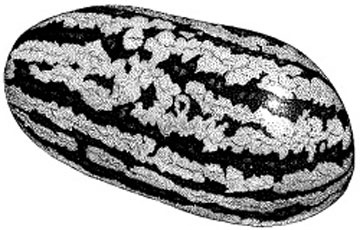
- Watermelon
Harvest when underside of fruit turns from whitish to yellowish. The tendril at the juncture of the fruit stem and the vine usually dies when the fruit is mature. Thumping an immature melon gives a ringing metallic sound, while a mature melon gives a dull thud. Watermelons will store at room temperature for about 1 week and at a temperature of 45 to 50 degrees F for 2 or 3 weeks.
Other vegetables

- Eggplant
Harvest when fruits are nearly full-grown but color is still bright. Eggplants are not adapted to long storage. Keep in warmest part of refrigerator (45 to 50 degrees F) for about 1 week.

- Beans, green
Bean pods will be most tender when the small seed inside is one-fourth normal size. The pods become more fibrous as the beans mature. Harvest before pods begin to swell because of the developing bean seeds inside. Store green beans up to 1 week in perforated plastic bags in the warmest part of a refrigerator. Can or freeze surplus. - Okra
Harvest okra pods when they are 2 to 3 inches long. Over-mature pods are woody. Store in plastic bags in the warmest part of a refrigerator for about 1 week. Freeze surplus. - Peppers, sweet
Harvest when fruits are firm and full size. If red, yellow or other colored fruits are desired, leave on plant until mature color develops. Mature peppers will be sweeter than green peppers. Sweet peppers can be stored for 2 to 3 weeks in the warmest part of a refrigerator in plastic bags.
Cool, dry storage
(32 to 55 degrees F, 50 to 60 percent relative humidity)
- Onions, dry
Harvest onions when the tops have fallen over and the necks have shriveled. After digging, remove tops, place in shallow boxes or mesh bags, and cure in open garage or barn for 3 to 4 weeks. Store in mesh bags in as cool a place as can be found in midsummer (32 to 35 degrees F). During humid, muggy weather, keep ventilated. - Peppers, hot
Pull plants late in the season and hang to dry in sun or a warm place. Store in a dry cool place, usually a basement.
Warm, dry storage
(55 to 60 degrees F, 60 to 70 percent relative humidity)
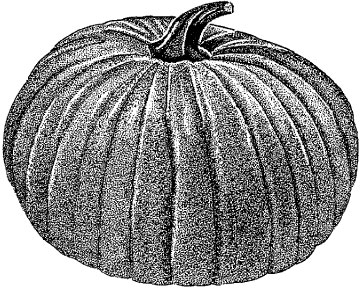
- Pumpkins, winter squash
Harvest pumpkins and winter squash when the skin is hard and the colors darken. Both should be harvested before frost. Remove the fruit from the vine with a portion of the stem attached. Store on shelves in a single layer so air can circulate around them.
Warm, moist storage
(55 to 60 degrees F, 80 to 85 percent relative humidity)
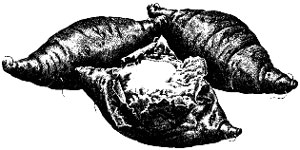
- Sweet potatoes
Harvest in fall before frosts and freezing temperatures. Handle carefully in the digging process. Cure for 1 week at temperature of 80 to 85 degrees F. Ideal storage is at 55 degrees F and 85 percent relative humidity, which might be accomplished in a basement with ventilated boxes covered with periodically moistened burlap sacks.

- Tomato
Ripe tomatoes will keep for 1 week at 55 to 60 degrees F. Green, mature tomatoes, harvested before frost, should be kept at a temperature between 55 and 70 degrees F. For faster ripening, raise temperature to 65 to 70 degrees F. Mature green tomatoes should approach normal size and have a whitish green skin color. Keep mature green tomatoes from 3 to 5 weeks by wrapping each tomato in newspaper and inspecting for ripeness each week. Do not store tomatoes in a refrigerator.